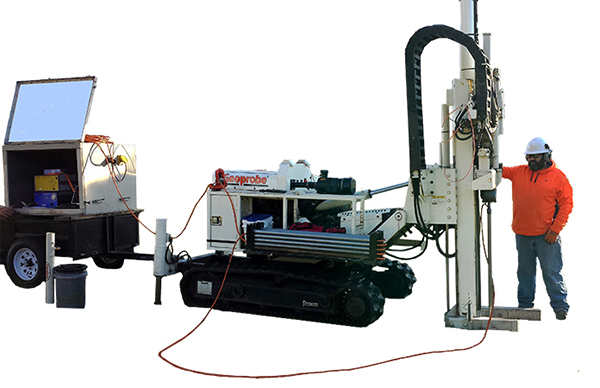General Overview of Investigation Process
For a general overview of the basic elements of the field investigation process, please see the General Investigation Process page.
Hydraulic Profiling Tool Investigation Process
Permeability and Estimated k
 The Hydraulic Profiling Tool (HPT) utilizes pressure measurements to quantify the permeability of the medium the probe is being advanced through and estimate a hydraulic conductivity (k) value. To accomplish this, water is pumped through a down-hole transducer at approximately 250 mL/min into the formation. Pressure and flow are plotted vs. depth and the resulting line graph lends insight into permeability of the subsurface.
The Hydraulic Profiling Tool (HPT) utilizes pressure measurements to quantify the permeability of the medium the probe is being advanced through and estimate a hydraulic conductivity (k) value. To accomplish this, water is pumped through a down-hole transducer at approximately 250 mL/min into the formation. Pressure and flow are plotted vs. depth and the resulting line graph lends insight into permeability of the subsurface.
Dissipation Testing
Subsurface zones below the water table which have low pressure and high flow are ideal zones to run dissipation tests. Dissipation tests are tests that allow pressure to equilibrate to hydrostatic pressure for a particular depth, and from that measurement, a potentiometric surface (water table) can be calculated. Once the water table surface is calculated, estimated k values can be calculated for the saturated portion of the boring.
Electrical Conductivity
Electrical Conductivity (EC) is logged jointly with the HPT data with a Wenner array. When viewed alongside pressure and flow data, EC data often is great complementary data to aid in identifying fine-grained zones vs. coarse-grained zones.
Quality Assurance/Quality Control
In order to validate data from the borings, pre- and post-log QA/QC is recommended. These measures include testing the Wenner array on the EC portion of the probe, and pressure tests on the down-hole transducer. At a minimum, either the pre-log or post-log test is completed to calculate estimated k values. The tests are quick, and generally take less than 5 minutes.